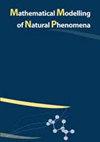动脉粥样硬化炎症过程的数学模型
IF 2.1
4区 数学
Q2 MATHEMATICAL & COMPUTATIONAL BIOLOGY
引用次数: 9
摘要
本文通过反应扩散型偏微分方程的数学模型研究动脉粥样硬化的早期阶段。该模型包括几个关键物种,并确定内皮细胞的高渗透性,被认为是动脉粥样硬化发病的前兆。我们将该系统简化为单调系统,并根据内皮功能为稳定性分析提供生物学解释。我们还研究了行波型解的存在性,并进行了数值模拟。所得结果与目前的生物学知识很好地吻合。同样地,他们证实并推广了先前文献中执行的数学模型的结果。然后,我们研究了非单调简化模型,并证明了摄动解和摄动波的存在性,特别是在双稳情况下。最后,我们考虑了最初提出的完整模型,进行了数值模拟,并给出了更具体的结果。我们研究了在一定参数范围内的简化模型和完备模型之间的一致性。我们精心制作了显示炎症在内皮通透性和LDL积累上的演变的分岔图。我们发现动脉粥样硬化进展的调节是由抗炎反应介导的,在一定程度上导致斑块消退。本文章由计算机程序翻译,如有差异,请以英文原文为准。
Mathematical Modeling of Inflammatory Processes of Atherosclerosis
In this paper we study the early stages of atherosclerosis via a mathematical model of partial differential equations of reaction-diffusion type. The model includes several key species and identifies endothelial hyperpermeability, believed to be a precursor on the onset of atherosclerosis. We reduce the system to a monotone system and provide a biological interpretation for the stability analysis according to endothelial functionality. We investigate as well the existence of solutions of traveling waves type along with numerical simulations. The obtained results are in good agreement with current biological knowledge. Likewise, they confirm and generalize results of mathematical models previously performed in literature. Then, we study the non monotone reduced model and prove the existence of perturbed solutions and perturbed waves, particularly in the bistable case. Finally, we consider the complete model proposed initially, perform numerical simulations and provide more specific results. We study the consistency between the reduced and complete models for a certain range of parameters. We elaborate bifurcation diagrams showing the evolution of inflammation upon endothelial permeability and LDL accumulation. We show that the regulation of atherosclerosis progression is mediated by anti-inflammatory responses that, up to certain extent, lead to plaque regression.
求助全文
通过发布文献求助,成功后即可免费获取论文全文。
去求助
来源期刊

Mathematical Modelling of Natural Phenomena
MATHEMATICAL & COMPUTATIONAL BIOLOGY-MATHEMATICS, INTERDISCIPLINARY APPLICATIONS
CiteScore
5.20
自引率
0.00%
发文量
46
审稿时长
6-12 weeks
期刊介绍:
The Mathematical Modelling of Natural Phenomena (MMNP) is an international research journal, which publishes top-level original and review papers, short communications and proceedings on mathematical modelling in biology, medicine, chemistry, physics, and other areas. The scope of the journal is devoted to mathematical modelling with sufficiently advanced model, and the works studying mainly the existence and stability of stationary points of ODE systems are not considered. The scope of the journal also includes applied mathematics and mathematical analysis in the context of its applications to the real world problems. The journal is essentially functioning on the basis of topical issues representing active areas of research. Each topical issue has its own editorial board. The authors are invited to submit papers to the announced issues or to suggest new issues.
Journal publishes research articles and reviews within the whole field of mathematical modelling, and it will continue to provide information on the latest trends and developments in this ever-expanding subject.
 求助内容:
求助内容: 应助结果提醒方式:
应助结果提醒方式:


